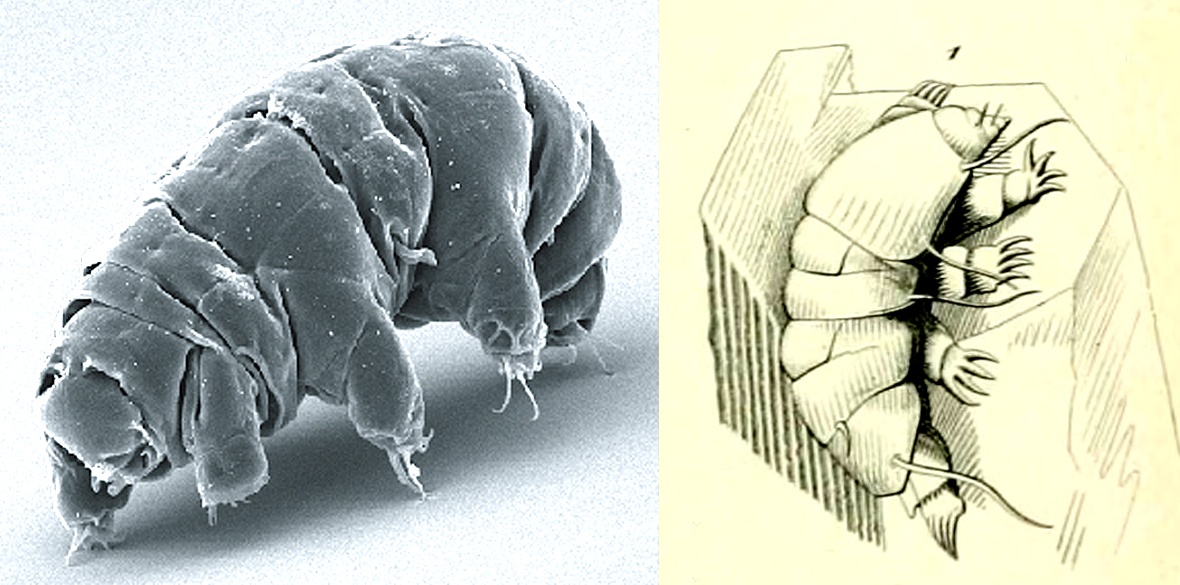Science and Society Imminent arrival of tardigrade aliens greatly exaggerated
The half a millimetre-long creatures that look like a tiny eight-legged caterpillar are resiliant beyond imagination and fascinate scientist as much as science-fiction writers

(L to R) SEM (scanning electron microscope) image of Milnesium tardigradum in active state and a drawing of a tardigrade on a grain of sand from 1840 Photo: (L to R) doi:10.1371/journal.pone.0045682.g001 and E de Laplante – Doyere/both Creative Commons
Lithopanspermia is a proposed method of life being distributed around the universe, whereby extremely hardy organisms might travel on rocks ejected from one planet that crash land on another. It means alien life forms travelling from one planet to another to start a new life.
The organisms that could potentially complete this journey would need to be very tough indeed. In the first place, they would need to survive within a rock travelling through space, which would subject them to very high doses of cosmic radiation.
The precise radioactive dose would depend on how long the rock is travelling between the two planets. Rocks that travel between Earth and Mars would be travelling so long that the dose received even deep in the centre of the rock would be enough to kill any known living organism.
However, even if the journey between two other planets might be short enough to permit a survivable dose of radiation, there are the extreme forces involved to consider. Being ejected from one planet’s surface and crash landing on another is unlikely to be a smooth process.
The forces at play would depend on the impact speed on the rock on the planet’s surface: higher speed means a larger force. The shock wave resulting from the impact of a space rock causes a huge, instant change in pressure that can be devastating. This effect is what causes the destruction seen for miles around the detonation site of atomic bombs.
Pressure is measured in pascals. One pascal is equivalent to a force of one newton acting on an area of one metre squared, with the pressure of a car tyre being about 200 kilopascals (each equal to one thousand pascals).
For planetary impacts the impact speed would be at least several kilometres per second and the pressure that an organism would need to survive is measured in gigapascals, equivalent to 1,000,000,000 pascals.
What sorts of organisms might be able to survive this pressure? Extremophiles are a collection of organisms that thrive in conditions that would be considered unsuitable for other life forms.
While some organisms specialise in living in an environment that would be considered extreme in one aspect, such as very low or high temperatures or in very acidic environments, some organisms are robust to more or less everything!
Extremophiles tend to be simpler organisms such as microbes, seeds, or spores. One particularly unusual example are the tardigrades, creatures that measure half a millimetre long and look like a tiny eight-legged caterpillar. Their unusual form also makes them look strangely mammalian (although they are not), and they are known commonly as “water bears” and “moss piglets.”
Tardigrades have become a poster child for tough animals. In one experiment, a group of tardigrades survived for 12 days in space enduring the complete lack of oxygen and exposure to radiation that we are protected from by the atmosphere.
The toughness of tardigrade’s toughness makes them an interesting organism for lithopanspermia researchers. If you are a science fiction fan you may have seen an alien life form with a close resemblance to a large tardigrade that can use a fictional “mycelial” network to travel between different parts of the galaxy on the Star Trek: Discovery series.
Tardigrades have such survivability because they can enter what is known as the “tun” state. They become completely dried out and pause their metabolism until the environmental conditions return to something most conducive to life.
Tardigrades in the tun state have been kept at -190°C for 21 months and have been crushed in an anvil with the pressure of 7.5 gigapascals, both times returning to life afterwards. However, this pressure is not the same sort of “shock pressure” that would be experienced in a space rock impact.
Recently, researchers at the University of Kent have published experiments testing whether tardigrades could plausibly survive the shock pressure of their intergalactic rock colliding with a planet. Citing an experiment from 2017, which found that bacteria could survive much higher pressures from static pressure (such as anvil or press) compared to shock pressure (such as an asteroid impact or bomb), the researchers tested how resilient tardigrades in the tun state are to shock pressure by firing them very quickly at a target made of sand.
They found that, similarly to the bacteria, tardigrades could withstand a much smaller amount of shock pressure, with the upper limit for tardigrade survival being 1.14 gigapascals corresponding to when they hit the sand target at 1 kilometre per second. Above that shock pressure they died.
The sacrifice of the tardigrades was not in vain, as this upper limit of shock force survival rules out interplanetary tardigrade travel on rocks in most scenarios since these rocks are more often than not travelling much faster, often 5 kilometres per second or faster. This casts serious doubt on the possibility that tardigrades were introduced to Earth from another planet.
However, the researchers note that other forms of tardigrade transference between planets and their moons might be possible, since impact speeds in this scenario could be much lower. One example given is smaller bits of rock flying off the Earth due to the impact of a large asteroid. Some of these smaller bits of rock could have left Earth and reached the Moon.
This work is a neat illustration of the process of science, evaluating the plausibility of a grand hypothesis like lithopanspermia using considered, earth-bound experiments.
This article re-posted from: The Morning Star https://morningstaronline.co.uk/article/f/one-small-step-science-one-giant-leap-tardigrades